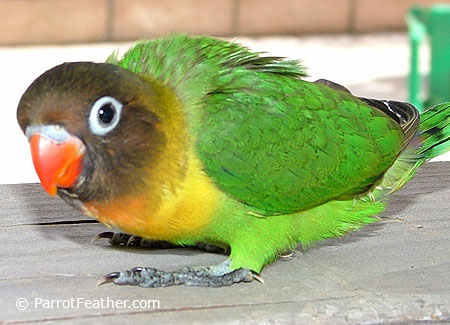Lovebird Biting (Part 1)

Just like any other parrot, lovebirds have behavioral issues. Lovebirds are intelligent creatures and are continuously challenging their owners in many ways. Some bite, scream, chew, or pluck. Whatever the issue, it can usually be worked out. Keep in mind that it is going to take some patience and time. Any pet owner knows that success does not come overnight. Like other animals, lovebirds require training and teaching to be successful and obedient in their environments. A little time and persistence is the key. Never get discouraged if results are not immediate. Pet owners can get good results if they put the proper time into molding their pets’ behavior.
Reasons Lovebirds Bite
Lovebirds bite for many reasons. Some bite out of fear, others to protect their territory, and some to get your attention. Whatever the reason, it is important to analyze the problem from the birds prospective. Just like people, birds can also get frustrated. This frustration can bring them to express their moods through biting or nipping. Though not all lovebirds will bite, most owners will encounter getting bitten at least once or twice, some on a regular basis. It’s important to understand that most behaviors can be changed.
Bonded Biting
It should be noted that lovebirds can be very jealous. These species
mate for life. As a result, they tend to bite people who they perceive
as a threat to their relationship. This can include family members or
people the lovebird rarely sees. This is why lovebirds can bite when a
stranger or a family member enters the room. Your lovebird is trying to
tell you to stay away. Keep in mind, lovebirds cannot talk or
communicate like we do, so the lovebird resorts to biting. In the
lovebird’s eyes, it’s hoping to distract you and remove you from that
environment.
In a lovebird colony, a jealous lovebird will be quick to put its
competitor in their place by using aggression—family members or friends
are not exempt.
Remedying this problem takes time and persistence. The owner must show
the parrot that interaction with other people should not be looked at as
a threat. Letting the lovebird know that other people can be enjoyable
takes time. Have friends or family members interact, pet, and feed the
bird. If the lovebird’s aggression is unbearable, gradually introduce
the lovebird to a social situation. Start by placing your lovebird on a
stand when company is present and encourage them to talk or offer treats
to the bird. This helps ease the parrot and subsides feelings of
jealousy. The bird will be focused on receiving attention or food rather
then fighting to keep people away from you. Most lovebirds show
aggression towards the beginning, but if practiced, it will become
routine and the lovebird will be more open to letting others interact
with it.




